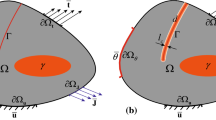Abstract
Fracture of heterogeneous materials under cycling loading is investigated by using a simple deterministic model. A material is simulated by an inhomogeneous two-dimensional square lattice. Characteristics of the fracture process are studied as functions of the amplitude of the strain factor ΔR and the loading periodt p ; the durability of the material is also analyzed as a function of these parameters. It is shown that the degree of fracture in the system increases with ΔR for smallt p and is practically independent of ΔR for larget p . The fractal dimensionality remains constant under all conditions and is equal toD=1.10±0.04. Fracture clusters at points of destruction of the material (percolation clusters) are anisotropic and their width-to-length ratio (the anisotropy parameter) averaged over all possible configurations is equal to δ=0.18±0.10 (ΔE=90). A power decrease in the elasticity modulusE of the system with an index τ=0.39±0.17 is observed near the percolation threshold.
Similar content being viewed by others
References
B. B. Mandelbrot,The Fractal Geometry of Nature, New York (1982).
P. Meakin, “The growth of fractal aggregates and their fractal measures,” in:Phase Transitions, Vol. 12, Academic Press, New York (1988), pp. 336–489.
P. Meakin, “Simulation of aggregation processes,” in: D. Avnir (editor),The Fractal Approach to Heterogeneous Chemistry Wiley, New York (1989), pp. 131–160.
V. R. Regel', A. I. Slutsker, and É. E. Tomashevskii,Kinetic Theory of Durability of Solids [in Russian], Nauka, Moscow (1974).
V. Z. Parton,Mechanics of Fracture: From Theory to Practice [in Russian], Nauka, Moscow (1990).
S. B. Ratner and L. B. Potapova, “Prediction of the durability of polyamide composites under repeated loading,”Dokl. Akad. Nauk SSSR, No. 6, 1403–1406 (1989).
Z. V. Dobrodumov and A. M. El'yashevich, “Brittle fracture of polymers simulated in a lattice model by the Monte-Carlo method,”Fiz. Tverd. Tela 15, No. 6, 1891–1893 (1973).
H. J. Herrmann, A. Hansen, and S. Roux, “Fracture of disordered elastic lattices in two dimensions,”Phys. Rev. B39, No. 1, 637–648 (1989).
P. Meakin, “Simple models for crack growth,”Cryst. Prop. Prepar. 17–18, 1–54 (1988).
P. Meakin, G. Li, L. M. Sander, et al.,Simple Stochastic Models for Material Failure, Preprint, Wilmington, USA (1989).
P. Meakin, “Simple models for surface cracking,”MRS. Thin Films 130, 243–248 (1988).
H. Takayasu, “A deterministic model of fracture,”Progr. Theor. Phys. 74, No. 6, 1343–1345 (1985).
H. Takayasu, “Emergence of configurations of dendritic fractals caused by cracking and electrical breakdown,” in: L. Pietronero and E. Tosatti (editors),Fractals in Physics [Russian translation], Mir, Moscow (1988), pp. 249–254.
N. I. Lebovka, V. V. Mank, and F. D. Ovcharenko, “Brittle fracture and the durability equation for a heterogeneous plane square lattice,”Dokl. Akad. Nauk SSSR 315, No. 3, 401–405 (1990).
N. I. Lebovka and V. V. Mank, “Phase diagram and kinetics of inhomogeneous square lattice brittle fracture,”Physica A181, No. 2, 346–363 (1992).
N. I. Lebovka, F. D. Ovcharenko, and V. V. Mank, “Strain-induced disordering in the model of fracture of a heterogeneous plane square lattice subjected to nonstationary strains,”Dokl. Akad. Nauk SSSR 321, No. 1, 131–135 (1991).
S. N. Zhurkov, “Dilaton mechanism of durability of solids,”Fiz. Tverd. Tela 25, No. 10, 3119–3123 (1983).
D. Anderson, J. Tannehill, and R. Pletcher,Computational Fluid Mechanics and Heat Transfer [Russian translation], Mir, Moscow (1990).
J. Hoshen and R. Kopelman, “Percolation and cluster distribution. 1. Cluster multiple labeling technique and critical concentration algorithm,”Phys. Rev. B14, No. 8, 3488–3501 (1976).
J. Nittmann, G. Daccord, and H. Stanley, “When do viscid fingers have fractal dimension?” in: L. Pietronero and E. Tosatti (editors),Fractals in Physics [Russian translation], Mir, Moscow (1988), pp. 266–282.
I. Webman, “Elastic behavior of fractal structures,” in: L. Pietronero and E. Tosatti (editors),Fractals in Physics [Russian translation], Mir, Moscow (1988), pp. 488–497.
D. Stauffer, “Scaling theory of percolation cluster,”Phys. Rept. 54, No. 1, 1–74 (1979).
Additional information
Institute of Biocolloid Chemistry, Ukrainian Academy of Sciences, Kiev. Translated from Fiziko-Khimicheskaya Mekhanika Materialov, Vol. 30, No. 1, pp. 88–96, January–February, 1994.
Rights and permissions
About this article
Cite this article
Lebovka, N.I., Mank, V.V. & Pivovarova, N.S. Simulation of the fracture of heterogeneous materials under cyclic loading. Mater Sci 30, 87–94 (1995). https://doi.org/10.1007/BF00559022
Received:
Issue Date:
DOI: https://doi.org/10.1007/BF00559022




